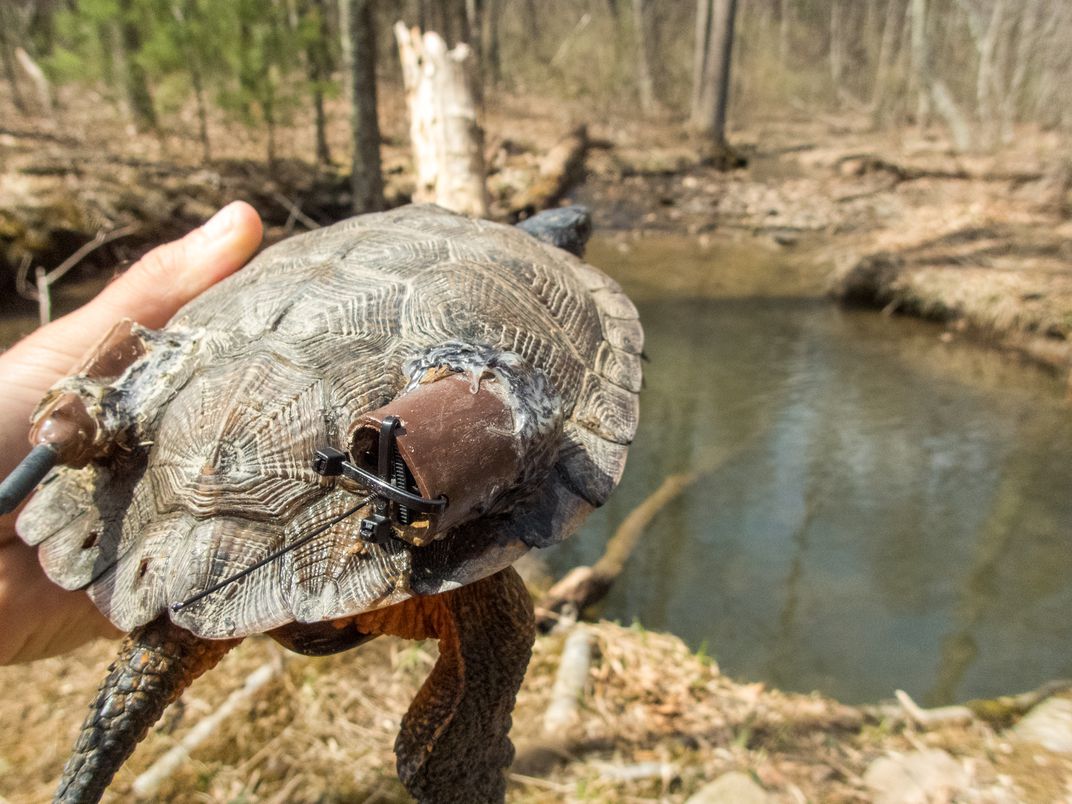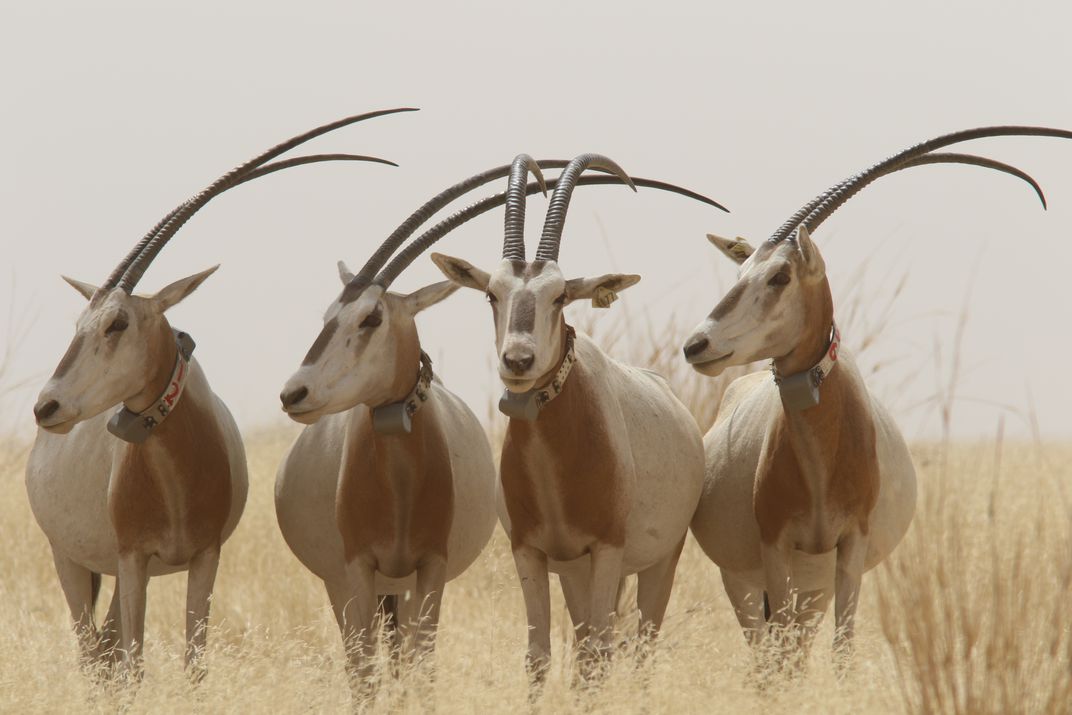Smithsonian scientists use technology to track animals

Tracking units on the shell of a wood turtle. The tracking information these GPS units collect is used to understand how wood turtles move throughout the year. Image credit: Smithsonian's Movement of Life
Whether it is to find food, shelter and mates; to socialize; to find protection from predators, or to stay comfortable and healthy, animals are always on the move. Birds and marine animals migrate thousands of miles in search of a year’s worth of warmth, nutrients, and suitable nesting grounds. Elephants walk hundreds of miles for food and water. Other land mammals scurry around their local habitats to gather resources, mate, and sleep.
Most of these movements are not easy to see on a broad scale. But with the latest tracking technology, the Smithsonian’s Movement of Life program is able to monitor the movements of animal populations at twenty sites across the globe. Whether it is through GPS tracking collars on scimitar-horned oryxes in Chad or satellite tags on birds in Maryland, an animal’s movement can tell our scientists whether their population is healthy, if its habitat is under threat, and whether scientists are succeeding in creating a better environment for these creatures.
Tiny Tracking Devices

To track small animals, scientists must get creative. With the recent miniaturization of GPS technology, scientists can attach tracking devices that weigh less than half an ounce to smaller animals, allowing researchers to collect detailed movement data and without hampering the animal’s movement. This technology is used in different forms on dozens of animals, ranging from the endangered wood turtle to small birds, like warblers.
Wood turtle populations have dropped rapidly over the last several decades due to a combination of slow reproduction time and modern human threats. To combat this decline, Smithsonian scientists have been closely monitoring wood turtle populations since 2011 and have been tracking individuals since 2016. Over the past three years, 36 individual turtles have been tracked in this way.
The tracking information these GPS units collect is being used to understand how wood turtles move across and use the landscape throughout the year. Smithsonian scientists have found that they travel as much as 13 miles to meet their needs, which puts them at greater risk than if they stayed in a smaller radius. The movement data can help inform work that supports the health and safety of these endangered turtles as they live their lives in the wild.
For small birds like warblers, scientists at Smithsonian’s Migratory Bird Center (SMBC) use radio tags, which they use radio receivers to communicate with. The trackers can weigh as little as 60 milligrams—that’s approximately the weight of two grains of rice—so they do not hinder the movement of warblers that generally weigh only up to half an ounce. For birds that fly further distances, SMBC scientists have used these radio tags to track their migrations, and incorporated these data into the Motus Wildlife Tracking System, an international, coordinated bird tracking network. SMBC scientists have also used this technology to study the movement of birds within their territories, and the survival of young birds after they leave the nest.
A Larger Solution

When tracking larger animals, scientists often use GPS tracking collars. In the case of Asian Elephants, these collars weigh less than one percent of the elephant’s body weight (which is still quite heavy—Asian Elephants can weight up to 12,000 pounds!).
Scientists also use collars to track the endangered scimitar-horned oryx. Existing only in human care for the past 30 years, the oryx was driven to extinction in the wild by over-hunting and scarce resources. In 2012, several organizations, including the Smithsonian’s National Zoo and Conservation Biology Institute, came together to attempt to reintroduce the oryx into its natural habitat. In a 2016 conservation success story, 21 oryx were reintroduced into a large, protected area in central Chad. To date, more than 240 oryx have been released into the Reserve and the wild population is now more than 600 animals.
But the success did not come without challenges. Nearly every adult reintroduced to the reserve is fitted with a GPS/satellite collar to monitor their seasonal movement patterns, social dynamics, and their use of resources. Collars remain on animals for approximately two years and include a “drop off” feature that allows remote removal from any animal at any time. GPS collars cannot be fit on oryx younger than 18 months old, because their necks grow too fast to safely wear a collar. In addition, to keep collars light enough to avoid potential health impacts, they only contain batteries that will last 2-3 years.
Movement of Life scientists are working with GPS tracking manufacturers to develop a solar-powered, horn-mounted GPS tag that could be fit on an oryx as young as one year old, and function for 4-5 years. This tag would be minimally invasive, expand the monitoring window for each individual, and lead to a greater understanding of the basic needs and habits of this species, as well as inform management practices during future releases.
Tracking Animals Underwater
Tracking ocean animals can be challenging, with certain species traveling thousands of miles underwater hidden from human sight. Researchers use a technique called acoustic telemetry to learn more about where animals such as sharks and rays travel. Scientists implant transmitters into individual animals, who are then safely released back into the water. With over 200 receiver stations throughout the east coast, scientists track individuals as they move about the Chesapeake Bay and then migrate along the Atlantic Coast to Florida.
This technique helped scientists at the Smithsonian Environmental Research Center unravel the mystery of cownose ray migration. For years the movement patterns of cownose rays were unknown. But in 2018, Smithsonian scientist Matt Ogburn and a post-doctoral fellow at the time, Chuck Bangley, led the first project to track cownose rays’ complete migrations along the coast. The team discovered that, even though cownose rays can live in many parts of the East Coast during the summer, most winter in the same place—near Cape Canaveral, Florida. They have also looked at how climate change may impact the rays’ migrations. Cownose ray fishing is currently unregulated, despite evidence that they only produce about one new pup a year, which makes them highly susceptible to overharvesting. Movement data like this will help inform regulations that aim to protect this fragile species.
